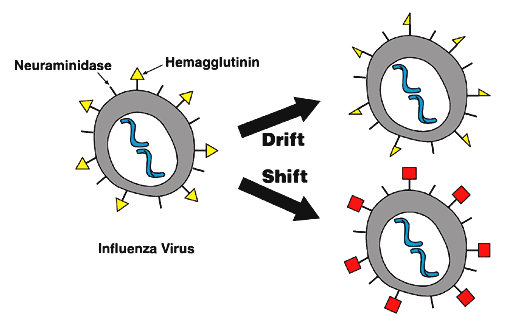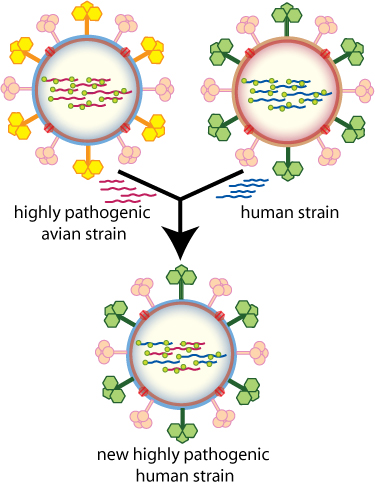|
|
| Line 2: |
Line 2: |
| {{Influenza}} | | {{Influenza}} |
| {{CMG}} | | {{CMG}} |
| | ==Overview== |
|
| |
|
| ==Pathophysiology== | | ==Pathophysiology== |
| Influenza infects many animal species and transfer of viral strains between species can occur. Birds are thought to be the main [[host (biology)|animal reservoir]]s of influenza viruses.<ref>{{cite journal | author = Gorman O, Bean W, Kawaoka Y, Webster R | title = Evolution of the nucleoprotein gene of influenza A virus. | url=http://www.pubmedcentral.nih.gov/articlerender.fcgi?tool=pubmed&pubmedid=2319644 | journal = J Virol | volume = 64 | issue = 4 | pages = 1487–97 | year = 1990 | id = PMID 2319644}}</ref> Sixteen forms of [[hemagglutinin]] and 9 forms of [[neuraminidase]] have been identified. All known subtypes (HxNy) are found in birds but many subtypes are endemic in humans, dogs, horses, and pigs; populations of camels, ferrets, cats, seals, mink, and whales also show evidence of prior infection or exposure to influenza. Variants of flu virus are sometimes named according to the species the strain is endemic in or adapted to. The main variants named using this convention are: Bird flu, [[Human flu|Human Flu]], Swine Flu, Horse Flu and Dog Flu. (Cat flu generally refers to Feline viral rhinotracheitis or Feline calicivirus and not infection from an influenza virus.) In pigs, horses and dogs, influenza symptoms are similar to humans, with cough, fever and loss of appetite. The frequency of animal diseases are not as well-studied as human infection, but an outbreak of influenza in harbour seals caused approximately 500 seal deaths off the New England coast in 1979–1980.<ref>{{cite journal | author = Hinshaw V, Bean W, Webster R, Rehg J, Fiorelli P, Early G, Geraci J, St Aubin D | title = Are seals frequently infected with avian influenza viruses? | url=http://www.pubmedcentral.nih.gov/articlerender.fcgi?tool=pubmed&pubmedid=6471169 | journal = J Virol | volume = 51 | issue = 3 | pages = 863-5 | year = 1984 | id = PMID 6471169}}</ref> On the other hand, outbreaks in pigs are common and do not cause severe mortality.
| | *Most healthy adults may be able to infect other people beginning 1 day before symptoms develop and up to 5 to 7 days after becoming sick. |
| | *Children may pass the virus for longer than 7 days. |
| | *Symptoms start 1 to 4 days after the virus enters the body. |
| | *That means that you may be able to pass on the flu to someone else before you know you are sick, as well as while you are sick. Some people can be infected with the flu virus but have no symptoms. During this time, those persons may still spread the virus to others. |
|
| |
|
| Flu symptoms in birds are variable and can be unspecific.<ref>{{cite journal | author = Elbers A, Koch G, Bouma A | title = Performance of clinical signs in poultry for the detection of outbreaks during the avian influenza A (H7N7) epidemic in The Netherlands in 2003. | journal = Avian Pathol | volume = 34 | issue = 3 | pages = 181-7 | year = 2005 | id = PMID 16191700}}</ref> The symptoms following infection with low-pathogenicity avian influenza may be as mild as ruffled feathers, a small reduction in egg production, or weight loss combined with minor respiratory disease.<ref>Capua I, Mutinelli F. "Low pathogenicity (LPAI) and highly pathogenic (HPAI) avian influenza in turkeys and chicken." In: Capua I, Mutinelli F. (eds.), A Colour Atlas and Text on Avian Influenza, Papi Editore, Bologna, 2001, pp. 13–20</ref> Since these mild symptoms can make diagnosis in the field difficult, tracking the spread of avian influenza requires laboratory testing of samples from infected birds. Some strains such as Asian [[H9N2]] are highly virulent to poultry, and may cause more extreme symptoms and significant mortality.<ref>{{cite journal | author = Bano S, Naeem K, Malik S | title = Evaluation of pathogenic potential of avian influenza virus serotype H9N2 in chickens. | journal = Avian Dis | volume = 47 | issue = 3 Suppl | pages = 817-22 | year = 2003 | id = PMID 14575070}}</ref> In its most highly pathogenic form, influenza in chickens and turkeys produces a sudden appearance of severe symptoms and almost 100% mortality within two days.<ref>{{cite journal | author = Swayne D, Suarez D | title = Highly pathogenic avian influenza. | journal = Rev Sci Tech | volume = 19 | issue = 2 | pages = 463-82 | year = 2000 | id = PMID 10935274}}</ref> As the virus spreads rapidly in the crowded conditions seen in the intensive farming of chickens and turkeys, these outbreaks can cause large economic losses to poultry farmers.
| |
|
| |
|
| An avian-adapted, highly pathogenic strain of H5N1 (called HPAI A(H5N1), for "highly pathogenic avian influenza virus of type A of subtype H5N1") causes [[transmission and infection of H5N1|H5N1 flu]], commonly known as "avian influenza" or simply "bird flu", and is [[endemic (epidemiology)|endemic]] in many bird populations, especially in Southeast Asia. This Asian lineage strain of HPAI A(H5N1) is [[global spread of H5N1|spreading globally]]. It is [[epizootic]] (an epidemic in non-humans) and panzootic (a disease affecting animals of many species, especially over a wide area) killing tens of millions of birds and spurring the culling of hundreds of millions of other birds in an attempt to control its spread. Most references in the media to "bird flu" and most references to H5N1 are about this specific strain.<ref>{{cite journal | author = Li K, Guan Y, Wang J, Smith G, Xu K, Duan L, Rahardjo A, Puthavathana P, Buranathai C, Nguyen T, Estoepangestie A, Chaisingh A, Auewarakul P, Long H, Hanh N, Webby R, Poon L, Chen H, Shortridge K, Yuen K, Webster R, Peiris J | title = Genesis of a highly pathogenic and potentially pandemic H5N1 influenza virus in eastern Asia. | journal = Nature | volume = 430 | issue = 6996 | pages = 209-13 | year = 2004 | id = PMID 15241415}}</ref><ref>Li KS, Guan Y, Wang J, Smith GJ, Xu KM, Duan L, Rahardjo AP, Puthavathana P, Buranathai C, Nguyen TD, Estoepangestie AT, Chaisingh A, Auewarakul P, Long HT, Hanh NT, Webby RJ, Poon LL, Chen H, Shortridge KF, Yuen KY, Webster RG, Peiris JS. [http://darwin.nap.edu/books/0309095042/html/116.html "The Threat of Pandemic Influenza: Are We Ready?" Workshop Summary] The National Academies Press (2005) "Today's Pandemic Threat: Genesis of a Highly Pathogenic and Potentially Pandemic H5N1 Influenza Virus in Eastern Asia", pages 116–130</ref>
| | ===Transmission=== |
| | |
| | *People with influenza infection can spread the disease to others up to about 6 feet away. |
| | *Most experts think that influenza viruses are spread mainly by droplets made when people with flu cough, sneeze or talk. |
| | *These droplets can land in the mouths or noses of people who are nearby or possibly be inhaled into the lungs. |
| | *Less often, a person might also get flu by touching a surface or object that has flu virus on it and then touching their own mouth or nose. |
| | *To avoid this, people should stay away from sick people and stay home if sick. |
| | *It also is important to wash hands often with soap and water. |
| | *If soap and water are not available, use an alcohol-based hand rub. |
| | *Linens, eating utensils, and dishes belonging to those who are sick should not be shared without washing thoroughly first. |
| | *Eating utensils can be washed either in a dishwasher or by hand with water and soap and do not need to be cleaned separately. Further, frequently touched surfaces should be cleaned and disinfected at home, work and school, especially if someone is ill. |
|
| |
|
| At present, HPAI A(H5N1) is an avian disease and there is no evidence suggesting efficient human-to-human transmission of HPAI A(H5N1). In almost all cases, those infected have had extensive physical contact with infected birds.<ref>{{cite journal | author = Liu J | title = Avian influenza—a pandemic waiting to happen? | url=http://jmii.org/content/pdf/v39n1p4.pdf | journal = J Microbiol Immunol Infect | volume = 39 | issue = 1 | pages = 4–10 | year = 2006 | id = PMID 16440117}}</ref> In the future, H5N1 may mutate or reassort into a strain capable of efficient human-to-human transmission. Due to its high lethality and [[virulence]], its [[endemic (epidemiology)|endemic]] presence, and its large and increasing biological host reservoir, the H5N1 virus is the world's pandemic threat in the 2006–7 flu season, and billions of dollars are being raised and spent researching H5N1 and preparing for a potential [[influenza pandemic]].<ref name=Rosenthal> Rosenthal, E. and Bradsher, K. [http://www.nytimes.com/2006/03/16/business/16bird.html?_r=1&oref=slogin Is Business Ready for a Flu Pandemic?] The New York Times 16-03-2006 Accessed 17-04-2006</ref>
| |
| [[Image:Antigenic drift versus shift.png|thumb|center|400px|[[Antigenic drift]] creates influenza viruses with slightly-modified antigens, while [[antigenic shift]] generates viruses with entirely novel antigens.]] | | [[Image:Antigenic drift versus shift.png|thumb|center|400px|[[Antigenic drift]] creates influenza viruses with slightly-modified antigens, while [[antigenic shift]] generates viruses with entirely novel antigens.]] |
| [[Image:Influenza geneticshift.jpg|thumb|center|300px|How antigenic shift, or reassortment, can result in novel and highly pathogenic strains of human influenza]] | | [[Image:Influenza geneticshift.jpg|thumb|center|300px|How antigenic shift, or reassortment, can result in novel and highly pathogenic strains of human influenza]] |
| Line 18: |
Line 30: |
|
| |
|
| [[Category:Disease]] | | [[Category:Disease]] |
| [[Category:Mature chapter]]
| |
| [[Category:Pulmonology]] | | [[Category:Pulmonology]] |
| [[Category:Influenza| ]] | | [[Category:Influenza| ]] |
| [[Category:Infectious disease]] | | [[Category:Infectious disease]] |
| [[Category:Primary care]] | | [[Category:Primary care]] |
| [[Category:Needs overview]]
| |
|
| |
|
| {{WH}} | | {{WH}} |
| {{WS}} | | {{WS}} |

